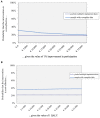Cost Effectiveness and Budget Impact of the Boston University Approach to Psychiatric Rehabilitation for Increasing the Social Participation of Individuals With Severe Mental Illnesses
- PMID: 35722578
- PMCID: PMC9199888
- DOI: 10.3389/fpsyt.2022.880482
Cost Effectiveness and Budget Impact of the Boston University Approach to Psychiatric Rehabilitation for Increasing the Social Participation of Individuals With Severe Mental Illnesses
Abstract
Background: The purpose of this study was to investigate the cost-effectiveness and budget impact of the Boston University Approach to Psychiatric Rehabilitation (BPR) compared to an active control condition (ACC) to increase the social participation (in competitive employment, unpaid work, education, and meaningful daily activities) of individuals with severe mental illnesses (SMIs). ACC can be described as treatment as usual but with an active component, namely the explicit assignment of providing support with rehabilitation goals in the area of social participation.
Method: In a randomized clinical trial with 188 individuals with SMIs, BPR (n = 98) was compared to ACC (n = 90). Costs were assessed with the Treatment Inventory of Costs in Patients with psychiatric disorders (TIC-P). Outcome measures for the cost-effectiveness analysis were incremental cost per Quality Adjusted Life Year (QALY) and incremental cost per proportional change in social participation. Budget Impact was investigated using four implementation scenarios and two costing variants.
Results: Total costs per participant at 12-month follow-up were € 12,886 in BPR and € 12,012 in ACC, a non-significant difference. There were no differences with regard to social participation or QALYs. Therefore, BPR was not cost-effective compared to ACC. Types of expenditure with the highest costs were in order of magnitude: supported and sheltered housing, inpatient care, outpatient care, and organized activities. Estimated budget impact of wide BPR implementation ranged from cost savings to €190 million, depending on assumptions regarding uptake. There were no differences between the two costing variants meaning that from a health insurer perspective, there would be no additional costs if BPR was implemented on a wider scale in mental health care institutions.
Conclusions: This was the first study to investigate BPR cost-effectiveness and budget impact. The results showed that BPR was not cost-effective compared to ACC. When interpreting the results, one must keep in mind that the cost-effectiveness of BPR was investigated in the area of social participation, while BPR was designed to offer support in all rehabilitation areas. Therefore, more studies are needed before definite conclusions can be drawn on the cost-effectiveness of the method as a whole.
Keywords: Boston University Approach to Psychiatric Rehabilitation; QALY; budget impact; cost-effectiveness; quality of life; severe mental illness; social participation.
Copyright © 2022 Sanches, Feenstra, Swildens, van Busschbach, van Weeghel and van Asselt.
Conflict of interest statement
The authors declare that the research was conducted in the absence of any commercial or financial relationships that could be construed as a potential conflict of interest.
Figures


References
-
- Burns-Lynch B, Brusilovskiy E, Salzer MS. An empirical study of the relationship between community participation, recovery, and quality of life of individuals with serious mental illnesses. Isr J Psychiatry Relat Sci. (2016) 53:46-54. - PubMed
LinkOut - more resources
Full Text Sources

